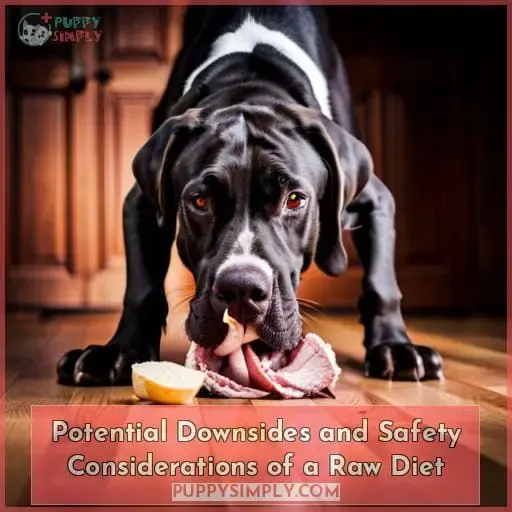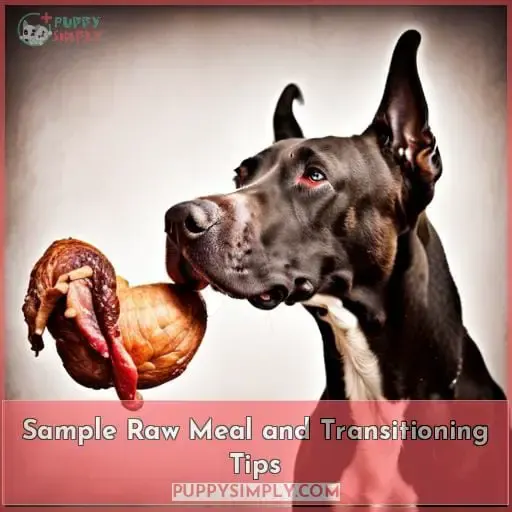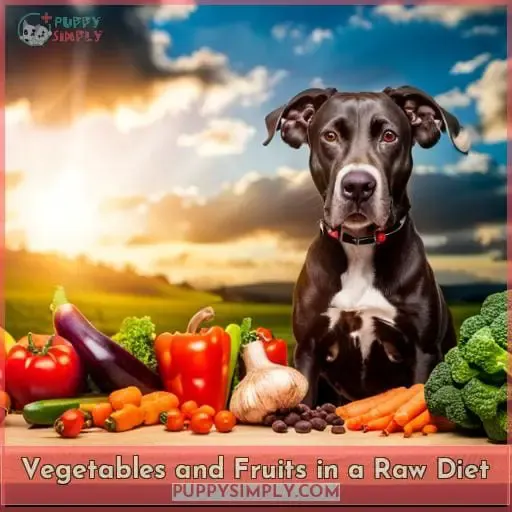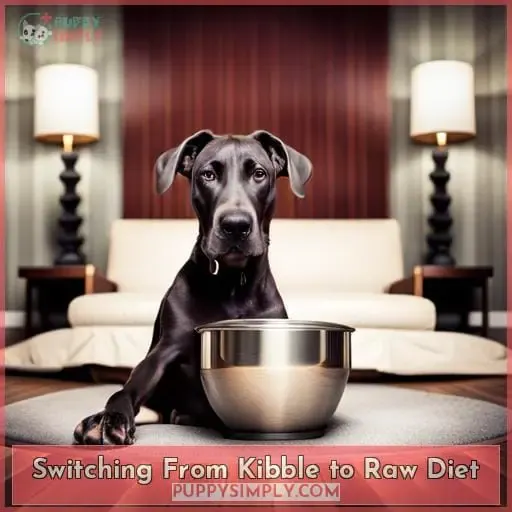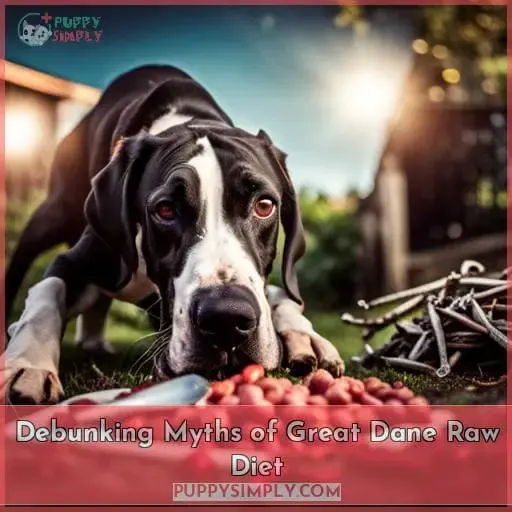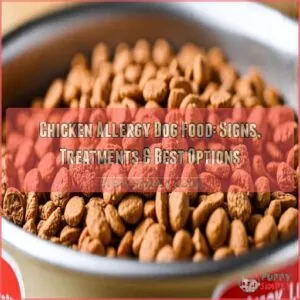This site is supported by our readers. We may earn a commission, at no cost to you, if you purchase through links.
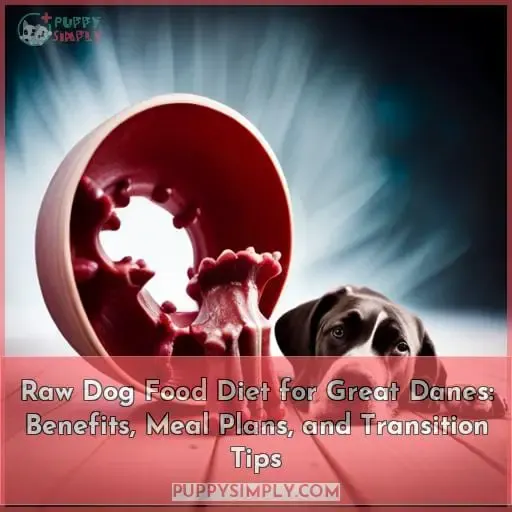 Imagine your Great Dane thriving on a diet that brings them closer to their natural roots.
Imagine your Great Dane thriving on a diet that brings them closer to their natural roots.
- Improved coat and skin health
- Strengthened immune system
- Weight management
- More control over your dog’s nutrition
In this article, we’ll explore the benefits of a raw diet for Great Danes along with meal plans and tips for transitioning smoothly.
Table Of Contents
- Key Takeaways
- Benefits of a Raw Diet for Great Danes
- Potential Downsides and Safety Considerations of a Raw Diet
- Sample Raw Meal and Transitioning Tips
- Vegetables and Fruits in a Raw Diet
- Switching From Kibble to Raw Diet
- Debunking Myths of Great Dane Raw Diet
- Dog Food Recommendations for Great Danes
- Supplements for Great Danes on a Raw Diet
- Frequently Asked Questions (FAQs)
- Can I feed my Great Dane a raw diet if they have a sensitive stomach?
- How do I ensure my Great Dane gets all the necessary nutrients on a raw diet?
- Is it necessary to add supplements to my Great Dane’s raw diet?
- Can I mix kibble and raw food in my Great Dane’s diet?
- Are there any specific bones that are safe for Great Danes to eat on a raw diet?
- Conclusion
Key Takeaways
- Improved coat and skin health
- Strengthened immune system
- Weight management
- Reduced feces volume and odo
Benefits of a Raw Diet for Great Danes
A raw diet for Great Danes offers several benefits.
First, it can lead to improved coat and skin health, resulting in a shinier and healthier-looking dog.
Second, the raw diet strengthens their immune system, making them less prone to illnesses.
Third, it helps with weight management by providing a balanced and nutrient-rich diet that supports healthy weight maintenance.
Additionally, feeding your Great Dane a raw diet can result in reduced feces volume and odor while giving you control over what goes into their food.
Improved Coat and Skin Health
Improve your Great Dane’s coat and skin health with a raw diet.
The benefits of a raw diet for Great Danes extend beyond just their overall health. By feeding them a raw diet, you can expect to see improvements in their skin and coat quality.
A few specific benefits include:
- Reduced risk of allergies and irritations
- Shinier, thicker coat
- Improved hydration from the moisture content in raw food
Strengthened Immune System
A raw diet for Great Danes strengthens their immune system, providing them with optimal health and vitality.
By feeding your Great Dane a raw dog food diet, you can boost their immune system and enhance their overall well-being.
The natural nutrients found in raw meat, organs, and fruits/vegetables promote improved immunity and disease resistance.
This dietary balance supports the body’s ability to fight off infections and maintain good health throughout your Great Dane’s life.
Weight Management
Maintaining a healthy weight is one of the significant benefits you can expect for your Great Dane when feeding them a raw diet.
Raw dog food provides nutritional balance and portion control, enabling better weight management for your pet.
By following proper feeding guidelines and incorporating exercise into their daily routine, you can prevent obesity in Great Danes.
Embracing a raw diet promotes lifestyle changes that contribute to their overall well-being and longevity.
Reduced Feces Volume and Odor
As you transition your Great Dane to a raw diet, you’ll notice a significant reduction in both the volume and odor of their feces.
Raw food contains fewer fillers and additives that can contribute to larger stools with strong odors. By providing your Great Dane with nutritionally balanced meals, their digestive system becomes more efficient, resulting in smaller and less smelly feces.
Control Over the Dog’s Diet
With a raw diet for Great Danes, you have control over your dog’s diet to ensure they receive the nutrition they need.
Customized nutrition is key in meal planning for your furry friend. By selecting the right ingredients and providing dietary variety, you can achieve optimal nutrient balance. This level of control allows you to tailor their meals based on individual needs and preferences, ensuring that your Great Dane thrives on a raw dog food diet.
Potential Downsides and Safety Considerations of a Raw Diet
While a raw diet can provide numerous benefits for Great Danes, it’s important to be aware of potential downsides and safety considerations.
One concern is the presence of harmful bacteria in raw meat, which can pose risks to both dogs and humans.
Another consideration is ensuring dietary balance, as a lack of essential nutrients or an excess of certain components may lead to health issues.
Additionally, transitioning to a raw diet may cause temporary diarrhea in some dogs.
It’s also worth noting that not all dogs are suitable candidates for a raw diet due to specific health conditions or sensitivities.
Lastly, the cost associated with sourcing quality ingredients for a raw diet should be taken into account when considering this feeding approach.
Harmful Bacteria in Raw Meat
Be cautious of harmful bacteria in raw meat when implementing a raw diet for your Great Dane.
Here are some key points to remember:
- Raw meat can contain harmful bacteria such as Salmonella and E.coli.
- Proper handling, storage, and hygiene practices are crucial to minimize the risk of bacterial contamination.
- Thoroughly wash hands, utensils, and surfaces after handling raw meat.
- Consult with your veterinarian for specific guidelines on safe food preparation and feeding practices.
Concerns About Dietary Balance
One concern regarding a raw diet for Great Danes is ensuring proper dietary balance.
Balancing nutrients and providing dietary variety can be challenging when feeding a raw diet.
To address this, it’s important to follow meal plans that include the right ratios of muscle meat, bone, liver, and other organs.
Additionally, nutritional supplements may be necessary to ensure all essential vitamins and minerals are provided.
Feeding puppies on a raw diet requires special attention to their specific nutrient needs during growth stages.
Risk of Diarrhea During Transition
During the transition to a raw diet for your Great Dane, you may experience bouts of diarrhea.
To manage diarrhea and ensure transition success, it’s important to prioritize digestive health.
Provide probiotics and digestive enzymes to support gut health, gradually introduce richer foods, and monitor your dog’s stool consistency throughout the process.
With proper care and attention, you can prevent and address any diarrhea issues during the transition period.
Inappropriateness for Certain Dogs
Not all dogs are suitable candidates for a raw diet due to individual health conditions or dietary restrictions. It’s important to consider breed-specific factors and consult with a veterinarian before switching from kibble to raw.
Raw diet risks include:
- Potential imbalances in nutrients
- Harmful bacteria in raw meat
- The risk of diarrhea during the transition
Don’t fall for common myths about the benefits of a raw diet—make an informed decision based on your dog’s specific needs.
Potential Cost Considerations
Consider the potential cost considerations when implementing a raw diet for your Great Dane.
Budgeting Tips:
- Plan ahead and calculate the cost of ingredients, supplements, and storage.
Economic Impact:
- Raw diets can be more expensive than commercial dog food.
Cost-Saving Strategies:
- Buy in bulk, source from local farms or butchers, and consider homemade options to reduce costs while still providing a nutritious diet.
Sample Raw Meal and Transitioning Tips
To ensure a balanced raw diet for your Great Dane, it’s important to understand the ratios of muscle meat, bone, liver, and other organs.
A sample raw meal could consist of:
- 70% muscle meat
- 10% bone
- 5% liver
- 5% other organs
Supplement options such as whole eggs for protein and omega fatty acids from raw fish can also be included in their diet.
When transitioning to a raw diet for your Great Dane puppy or adult dog, make sure to start with lean chicken or turkey while gradually introducing richer foods like beef or lamb to avoid digestive issues such as diarrhea.
Adding digestive enzymes and probiotics can further support a smooth transition process.
Ratios of Muscle Meat, Bone, Liver, and Other Organs
When transitioning your Great Dane to a raw diet, it’s important to regularly include the proper ratios of muscle meat, bone, liver, and other organs in their meals.
The recommended ratio for a balanced raw meal is 70% muscle meat, 10% bone, 5% liver, and 5% other organs. Supplements like fresh or frozen liver can be added to ensure nutritional needs are met.
Transitioning challenges may arise due to changes in digestion and taste preferences.
Supplement Options for a Balanced Diet
To ensure a balanced diet for your Great Dane on a raw food regimen, supplement options can be incorporated into their meals.
- Supplementing with fish oils, such as salmon or cod liver oil, provides essential omega-3 fatty acids that promote healthy skin and coat.
- Additionally, adding nutrient-rich ingredients like eggs and green tripe can further enhance the nutritional balance of their meals.
Consider consulting with a veterinarian to determine appropriate supplement options based on your dog’s specific needs and dietary considerations.
Feeding Guidelines for Puppies
To ensure proper growth and development, it’s essential to establish feeding guidelines for puppies transitioning to a raw diet.
- Determine the appropriate raw food amount based on the puppy’s body weight.
- Maintain nutritional balance by including muscle meat, bone, organ meats, and a variety of meats in their meals.
- Incorporate raw bones such as meaty bones for dental health and mental stimulation.
- Gradually transition puppies to a raw diet from their previous food to avoid digestive issues.
- Consider sourcing quality ingredients from natural food stores or trusted suppliers.
Transitioning Tips for a Smooth Switch
To smoothly transition your Great Dane to a raw diet, follow these tips and sample meal plans:
- Start with lean chicken or turkey for easier digestion and gradually introduce richer foods.
- Expect initial bouts of diarrhea during the transition period, but manage it by adding digestive enzymes and probiotics to support your dog’s gut health.
- Monitor their stool consistency as an indicator of transitioning success.
Vegetables and Fruits in a Raw Diet
Including vegetables and fruits in a raw diet for your Great Dane provides non-essential nutrients that can contribute to their overall health. However, it’s important to be aware of toxic foods such as onions and grapes, which should be avoided.
When introducing new ingredients, do so gradually to monitor any potential adverse reactions or allergies. Additionally, cooking or chopping vegetables can aid in improved digestion for your dog on a raw diet.
Non-Essential Nutrients
As you continue to explore the benefits and meal plans of a raw dog food diet for Great Danes, let’s now delve into the role of non-essential nutrients such as vegetables and fruits in this type of diet.
While dogs don’t require these foods for survival, they can provide additional vitamins, minerals, antioxidants, and fiber. It’s important to gradually introduce new ingredients to ensure proper digestion and avoid toxic foods like onions and grapes.
Cooking or chopping vegetables can also improve their digestibility for your Great Dane.
Toxic Foods to Avoid
Avoid toxic foods like onions and grapes when incorporating vegetables and fruits into your Great Dane’s raw diet. These foods can be harmful to dogs and should be avoided to ensure their health and well-being.
In addition, it’s important to introduce new ingredients gradually to prevent any adverse reactions. Always prioritize the safety of your dog by being aware of potential toxic foods in their raw diet.
- Onions
- Grapes
- Avocado pits or skin
- Raw potatoes
Introducing New Ingredients Gradually
When transitioning your Great Dane to a raw diet, it’s important to introduce new ingredients gradually over time.
This gradual introduction allows for the adjustment of their digestive system and ensures that they receive a balanced diet.
By incorporating ingredient variety such as vegetables and fruits into their meals, you can provide them with essential nutrients.
However, safety measures should be taken to avoid toxic foods and ensure proper digestion.
Consulting resources like Chuck & Don’s can further guide you in this process while considering microbial presence concerns associated with raw food diets.
Cooking or Chopping Vegetables for Improved Digestion
To improve digestion in a raw diet for Great Danes, you can:
- Cook or chop vegetables before feeding them to your dog.
- Chopping vegetables into smaller pieces helps break down the cell walls and makes it easier for dogs to digest.
- Cooking vegetables also aids in digestion by partially breaking down complex carbohydrates and increasing their bioavailability.
- However, be mindful not to overcook as excessive heat can destroy important nutrients that benefit your dog’s health on a raw diet.
Switching From Kibble to Raw Diet
When switching your Great Dane from kibble to a raw diet, there’s no specific transition period required. However, it’s important to monitor your dog’s adjustment and preferences during the switch.
Keep an eye out for any signs of digestive distress or discomfort and make adjustments accordingly.
No Transition Period
When switching from kibble to a raw diet for your Great Dane, there’s no transition period that needs to be followed.
You can make an immediate switch without any need for gradual adjustments. This means that you don’t have to worry about any digestive distress or diarrhea during the transition process.
Additionally, since a raw diet provides all the necessary nutrients, there’s no need for supplements when feeding your Great Dane this way.
Monitoring Dog’s Adjustment and Preferences
As you transition your Great Dane from kibble to a raw diet, it’s important to monitor their adjustment and preferences.
- Pay attention to the duration of any diarrhea episodes during the switch and observe their stool consistency.
- Additionally, keep an eye on your dog’s energy levels and coat condition as these can indicate how well they’re adapting to the new diet.
- Take note of any changes in food preferences or aversions as well.
Debunking Myths of Great Dane Raw Diet
Let’s address some common concerns and myths surrounding the raw diet for Great Danes.
One myth is the worry about microbial presence in raw meat, but it’s important to note that dogs have strong stomach acid that can handle bacteria.
Another concern is the safety of feeding raw bones, but as long as they’re raw and appropriate in size, they can be safely consumed by your Dane.
Finally, let’s discuss suitable types of bones for a raw diet such as frames, brisket, tails, and fish frames.
Addressing Concerns About Microbial Presence
Addressing concerns about microbial presence in raw meat, let’s debunk myths surrounding the Great Dane raw diet.
- Dogs have strong stomach acid that can handle bacteria in raw meat.
- Raw bones are safe and appropriate for dogs when handled correctly. Avoid cooked bones as they can splinter and harm dogs.
- Pacific Salmon and Sea Trout should be avoided due to parasite risk.
- Proper handling and hygiene practices minimize the potential risks associated with raw meat consumption by Great Danes.
Safety of Raw Bones
To ensure the safety of raw bones in a Great Dane’s diet, it’s important to understand their appropriate use and debunk common myths surrounding them.
Contrary to popular belief, raw bones can be safe for dogs when chosen carefully. Avoid large bone sizes that may cause splintering and prioritize proper mineral ratios. Opt for smaller bones like frames or fish frames from whole prey as suitable options for a Great Dane’s raw diet.
Suitable Types of Bones for a Raw Diet
When feeding your Great Dane a raw diet, it’s important to choose suitable types of bones that are safe and appropriate for their size and chewing abilities.
Suitable types of bones for a raw diet include:
- Frames
- Brisket
- Tails
- Fish frames
- Knuckles
These bones provide necessary mental stimulation and help maintain dental health.
Avoid large leg bones or weight-bearing joints as they can be too hard for your Great Dane to chew safely.
Dog Food Recommendations for Great Danes
When it comes to choosing dog food for your Great Dane, there are two main options to consider:
- Dry dog foods (kibble)
- Raw feeding recommendations
Dry dog foods from brands such as Diamond Naturals, Fromm Family Foods, Holistic Select, Merrick Pet Care, and Nutrisource can provide a convenient option with balanced nutrition.
On the other hand, if you prefer a raw diet for your Great Dane’s specific needs and preferences, following guidelines like feeding raw meaty bones and including organ meats can ensure a well-rounded diet.
Dry Dog Foods (Kibble)
First, let’s discuss some dry dog food recommendations for Great Danes:
- Diamond Naturals
- Fromm Family Foods
- Holistic Select
These brands offer a variety of options that cater to the nutritional needs of Great Danes. Dry dog foods are convenient and easy to store, making them a popular choice among pet owners.
Consider factors such as price range, feeding schedule (2 meals/day), cost factors like location and distributor availability, and ingredients when selecting the right dry dog food for your Great Dane.
These health benefits can offset other expenses associated with their overall well-being.
Additionally, resources such as websites and Facebook groups provide further guidance on choosing the best dry dog food for your Great Dane’s specific needs.
Raw Feeding Recommendations
For Great Danes, a raw feeding diet is recommended to provide optimal nutrition and health benefits.
When it comes to raw feeding recommendations, prioritize meaty bones while avoiding weight-bearing bones.
Opt for hormone and antibiotic-free meats, but be cautious of Pacific Salmon and Sea Trout due to parasite risk.
Aim to feed approximately 3% of your dog’s healthy weight, increasing or decreasing as needed for maintaining a healthy weight range.
Supplements for Great Danes on a Raw Diet
To ensure optimal health and well-being for your Great Dane on a raw diet, it’s important to consider incorporating appropriate supplements.
- Glucosamine, MSM, and Chondroitin: These supplements are beneficial for older dogs with arthritis or joint issues. They help promote healthy cartilage and reduce inflammation.
- Lipped Green Mussel: This supplement contains omega-3 fatty acids and natural anti-inflammatory properties that can support joint health in Great Danes.
- Eggs: Eggs are an excellent source of essential nutrients such as protein, vitamins (including vitamin D), minerals like selenium, copper,and iron ,and Omega-3 fatty acids which contribute to overall skin health – promoting a shiny coat in Great Danes.
By including these supplements in your Great Dane’s raw diet plan,s you can help support their overall wellness by addressing specific needs like joint health
Frequently Asked Questions (FAQs)
Can I feed my Great Dane a raw diet if they have a sensitive stomach?
Feeding your Great Dane a raw diet may be beneficial for their sensitive stomach.
Raw food is easier to digest and can help alleviate digestive issues.
Monitor their response, consult with a veterinarian if needed.
How do I ensure my Great Dane gets all the necessary nutrients on a raw diet?
To ensure your Great Dane gets all necessary nutrients on a raw diet, focus on variety.
Include:
- Muscle meat
- Organ meat (especially liver)
- Raw bone
- Fruits
- Vegetables
Consider supplements for specific needs and consult with a veterinarian for tailored advice.
Is it necessary to add supplements to my Great Dane’s raw diet?
Supplementing your Great Dane’s raw diet isn’t necessary if you provide a balanced variety of meats, organs, bones, and fruits/vegetables. However, consult with a veterinarian for specific recommendations based on your dog’s individual needs.
Can I mix kibble and raw food in my Great Dane’s diet?
Yes, you can mix kibble and raw food in your Great Dane’s diet.
However, it’s important to note that the digestion process for kibble and raw food differs, so it may affect nutrient absorption.
Monitor your dog’s health and consult with a veterinarian for guidance.
Are there any specific bones that are safe for Great Danes to eat on a raw diet?
Great Danes on a raw diet can safely consume bones such as:
- Frames
- Brisket
- Tails
- Fish frames
These bone options provide important minerals and chewing satisfaction for your dog’s overall health and well-being.
Conclusion
To conclude, a raw dog food diet can offer numerous benefits for Great Danes, including:
- Improved coat and skin health
- A strengthened immune system
- Weight management
- More control over their nutrition
While there are potential downsides and safety considerations to keep in mind, such as harmful bacteria in raw meat and concerns about dietary balance, with proper precautions and transitioning tips, the raw diet can be a healthy and fulfilling choice for your Great Dane.
Consider consulting with a veterinarian for personalized advice and recommendations.


